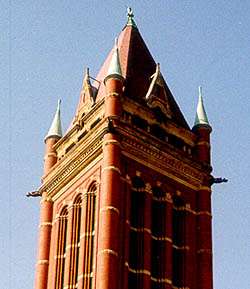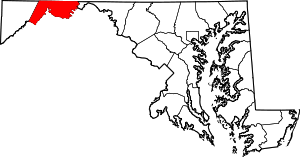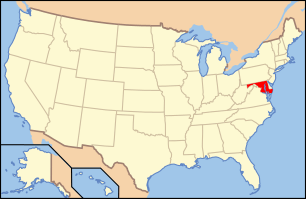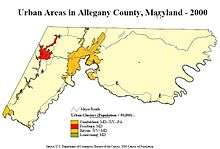Allegany County, Maryland
| Allegany County, Maryland | |||
|---|---|---|---|
| County | |||
| Allegany County | |||
 Allegany County Courthouse | |||
| |||
 Location in the U.S. state of Maryland | |||
 Maryland's location in the U.S. | |||
| Founded | December 25, 1789 | ||
| Named for | Allegheny Mountains | ||
| Seat | Cumberland | ||
| Largest city | Cumberland | ||
| Area | |||
| • Total | 430 sq mi (1,114 km2) | ||
| • Land | 424 sq mi (1,098 km2) | ||
| • Water | 5.8 sq mi (15 km2), 1.3% | ||
| Population (est.) | |||
| • (2015) | 72,528 | ||
| • Density | 169/sq mi (65/km²) | ||
| Congressional district | 6th | ||
| Time zone | Eastern: UTC-5/-4 | ||
| Website |
gov | ||
Allegany County is a county located in the northwestern part of the U.S. state of Maryland. As of the 2010 census, the population was 75,087.[1] Its county seat is Cumberland.[2] The name Allegany may come from a local Lenape word, welhik hane[3][4] or oolikhanna, which means 'best flowing river of the hills' or 'beautiful stream'.[5] A number of counties in the Appalachian region of the US are named Allegany, Allegheny, or Alleghany.
Allegany County is part of the Cumberland, MD-WV Metropolitan Statistical Area. It is a part of the Western Maryland "panhandle".
History
The western part of Maryland (including the present Allegany County) was originally part of Prince George's County when Maryland was formed in 1696.[6] This county included six current counties, and by repeated splitting, new ones were generated: Frederick from Prince George's in 1748;[7] and Montgomery and Washington from Frederick in 1776.[8]
Allegany County was formed in 1789 by the splitting of Washington County.[9] At the time it was the westernmost county in Maryland, but a split in 1872 produced Garrett County, the current westernmost county.[7]
Prior to 1789, the Virginia Commonwealth claimed the area of present-day Garrett and Allegheny Counties, of Maryland. A 1771-1780 map of Virginias counties, shows Hampshire County, but the Virginia State boundary has Hampshire outside that boundary line. When conducting genealogical research, it is possible to find tax records for Hampshire County, Virginia included in Maryland records, and Maryland records in Hampshire County... Hampshire County was formed in 1758 by the Virginia Commonwealth and at its founding, included the present day counties of Garrett & Allegheny Counties in Maryland, and Hardy, Grant, Mineral, and part of Morgan Counties in what is now West Virginia. Ref. Virginia Counties Map of 1771-1780; Henry Howe's 1845 History of Virginia.
The county has a number of properties on the National Register of Historic Places.[10]
Allegany County is often referred to as "Where the South Begins."
Geography
According to the U.S. Census Bureau, the county has a total area of 430 square miles (1,100 km2), of which 424 square miles (1,100 km2) is land and 5.8 square miles (15 km2) (1.3%) is water.[11]
Allegany County lies primarily in the Ridge-and-Valley Country of the Appalachian Mountains. It is bordered to the north by the Mason–Dixon line with Pennsylvania, to the south by the Potomac River and West Virginia, to the east by Sideling Hill Creek and Washington County, Maryland, and to the west by a land border with Garrett County, Maryland. The western part of the county contains a portion of the steep Allegheny Front, which marks the transition to the higher-elevation Appalachian Plateau and Allegheny Mountain region. The town of Frostburg is located west of the Front at an elevation of nearly 2,100 feet above sea level, while the county seat of Cumberland, only eight miles away, has an elevation of only 627 feet.
Mountains
- Breakneck Hill (1,872 ft)
- Collier Mountain (1,460 ft)
- Dans Mountain (2,898 ft)
- Evitts Mountain (1,959–2,260 ft.)
- Green Ridge Mountain
- Haystack Mountain (1,240+ ft.)
- Irons Mountain
- Martin Mountain (1,974 ft)
- Nicholas Mountain (1,760 ft)
- Piney Mountain
- Polish Mountain (1,783 ft)
- Ragged Mountain (1,740 ft)
- Town Hill (2,039 ft)
- Warrior Mountain (2,185 ft)
- Wills Mountain (1,960+ ft.)
Adjacent counties
- Somerset County, Pennsylvania (northwest)
- Bedford County, Pennsylvania (north)
- Fulton County, Pennsylvania (northeast)
- Washington County (east)
- Morgan County, West Virginia (southeast)
- Hampshire County, West Virginia (south)
- Mineral County, West Virginia (southwest)
- Garrett County (west)
National protected areas
Transportation
Major highways
-
 Interstate 68
Interstate 68 -
 U.S. Route 40
U.S. Route 40 -

 US 40 Alt.
US 40 Alt. -

 U.S. Route 40 Scenic
U.S. Route 40 Scenic -
 U.S. Route 220
U.S. Route 220 -
 Maryland Route 35
Maryland Route 35 -
 Maryland Route 36
Maryland Route 36 -
 Maryland Route 47
Maryland Route 47 -
 Maryland Route 49
Maryland Route 49 -
 Maryland Route 51
Maryland Route 51 -
 Maryland Route 53
Maryland Route 53 -
 Maryland Route 55
Maryland Route 55 -
 Maryland Route 135
Maryland Route 135 -
 Maryland Route 144
Maryland Route 144 -
 Maryland Route 638
Maryland Route 638 -
 Maryland Route 657
Maryland Route 657 -
 Maryland Route 658
Maryland Route 658 -
 Maryland Route 935
Maryland Route 935 -
 Maryland Route 936
Maryland Route 936 -
 Maryland Route 956
Maryland Route 956
Rail
Public transportation
Demographics
| Historical population | |||
|---|---|---|---|
| Census | Pop. | %± | |
| 1790 | 4,809 | — | |
| 1800 | 6,303 | 31.1% | |
| 1810 | 6,909 | 9.6% | |
| 1820 | 8,654 | 25.3% | |
| 1830 | 10,609 | 22.6% | |
| 1840 | 15,690 | 47.9% | |
| 1850 | 22,769 | 45.1% | |
| 1860 | 28,348 | 24.5% | |
| 1870 | 38,536 | 35.9% | |
| 1880 | 38,012 | −1.4% | |
| 1890 | 41,571 | 9.4% | |
| 1900 | 53,694 | 29.2% | |
| 1910 | 62,411 | 16.2% | |
| 1920 | 69,938 | 12.1% | |
| 1930 | 79,098 | 13.1% | |
| 1940 | 86,973 | 10.0% | |
| 1950 | 89,556 | 3.0% | |
| 1960 | 84,169 | −6.0% | |
| 1970 | 84,044 | −0.1% | |
| 1980 | 80,548 | −4.2% | |
| 1990 | 74,946 | −7.0% | |
| 2000 | 74,930 | 0.0% | |
| 2010 | 75,087 | 0.2% | |
| Est. 2015 | 72,528 | [12] | −3.4% |
| U.S. Decennial Census[13] 1790-1960[14] 1900-1990[15] 1990-2000[16] 2010-2015[1] | |||
2000 census
As of the census[17] of 2000, there were 74,930 people, 29,322 households, and 18,883 families residing in the county. The population density was 176 people per square mile (68/km²). There were 32,984 housing units at an average density of 78 per square mile (30/km²). The racial makeup of the county was 93.02% White, 5.35% Black or African American, 0.15% Native American, 0.52% Asian, 0.03% Pacific Islander, 0.19% from other races, and 0.75% from two or more races. 0.76% of the population were Hispanic or Latino of any race. 29.0% were of German, 16.7% US or American, 12.8% Irish, 10.7% English and 5.3% Italian ancestry according to Census 2000.[18]
There were 29,322 households out of which 26.50% had children under the age of 18 living with them, 50.60% were married couples living together, 10.30% had a female householder with no husband present, and 35.60% were non-families. 30.10% of all households were made up of individuals and 15.20% had someone living alone who was 65 years of age or older. The average household size was 2.35 and the average family size was 2.90.
In the county the population was spread out with 20.60% under the age of 18, 11.20% from 18 to 24, 26.80% from 25 to 44, 23.50% from 45 to 64, and 17.90% who were 65 years of age or older. The median age was 39 years. For every 100 females there were 99.20 males. For every 100 females age 18 and over, there were 96.90 males.
The median income for a household in the county was $30,821, and the median income for a family was $39,886. Males had a median income of $31,316 versus $21,334 for females. The per capita income for the county was $16,780. About 9.70% of families and 14.80% of the population were below the poverty line, including 17.70% of those under age 18 and 9.50% of those age 65 or over.
As of 2010, Allegany County had a racial and ethnic population composition of 88.16% Non-Hispanic whites, 8.03% Blacks, 0.14% Native Americans, 0.76% Asians, 0.04% Pacific Islanders, 0.08% Non-Hispanics who reported some other race, 1.47% Non-Hispanics who reported two or more races and 1.44% Hispanics.
2010 census
As of the 2010 United States Census, there were 75,087 people, 29,177 households, and 17,959 families residing in the county.[19] The population density was 177.0 inhabitants per square mile (68.3/km2). There were 33,311 housing units at an average density of 78.5 per square mile (30.3/km2).[20] The racial makeup of the county was 89.2% white, 8.0% black or African American, 0.8% Asian, 0.1% American Indian, 0.2% from other races, and 1.6% from two or more races. Those of Hispanic or Latino origin made up 1.4% of the population.[19] In terms of ancestry, 31.8% were German, 14.6% were Irish, 11.9% were English, 11.8% were American, and 5.6% were Italian.[21]
Of the 29,177 households, 26.0% had children under the age of 18 living with them, 46.0% were married couples living together, 11.0% had a female householder with no husband present, 38.4% were non-families, and 31.6% of all households were made up of individuals. The average household size was 2.30 and the average family size was 2.86. The median age was 40.9 years.[19]
The median income for a household in the county was $37,747 and the median income for a family was $52,680. Males had a median income of $42,322 versus $29,594 for females. The per capita income for the county was $20,764. About 9.6% of families and 14.5% of the population were below the poverty line, including 18.3% of those under age 18 and 8.8% of those age 65 or over.[22]
Government and infrastructure
Allegany County was granted a home rule form of government in 1974. It is a strongly Republican county: the last Democrat to win a majority being Jimmy Carter in 1976.[23]
The North Branch Correctional Institution, (opened 2003), and the earlier adjacent Western Correctional Institution are operated by the Division of Corrections of the Maryland Department of Public Safety and Correctional Services, (with its headquarters in Baltimore, Maryland) is located in an unincorporated area of Allegany County, just southwest of Cumberland.[24] The prison housed male death row inmates, who were moved from the Maryland Correctional Adjustment Center, from June 2010 until death row was closed in 2014.[25] County Government is governed by a 3-member board of County Commissioners
| Position | Name | Affiliation | District | |
|---|---|---|---|---|
| President | Jacob C Shade | Republican | At-Large | |
| Commissioner | Creade V Brode Jr | Republican | At-Large | |
| Commissioner | William R Valentine | Republican | At-Large | |
| Position | Name | Affiliation | District | |
|---|---|---|---|---|
| Chief Judge | Mark Widmyer | Republican | At-Large | |
| Judge | Billie J Gilpin | Republican | At-Large | |
| Judge | Donna May | Republican | At-Large | |
| Position | Name | Affiliation | District | |
|---|---|---|---|---|
| Sheriff | Craig Robertson | Republican | At-Large | |
| Position | Name | Affiliation | District | |
|---|---|---|---|---|
| Clerk of the Court | Dawne D Lindsey | Republican | At-Large | |
| Position | Name | Affiliation | District | |
|---|---|---|---|---|
| Register of Wills | Rebecca D Drew | Republican | At-Large | |
| Position | Name | Affiliation | District | |
|---|---|---|---|---|
| States Attorney | Michael O Twigg | Republican | At-Large | |
| Position | Name | Affiliation | District | |
|---|---|---|---|---|
| Senate | George C. Edwards | Republican | First District | |
| House of Delegates | Wendell R. Beitzel | Republican | First District A | |
| House of Delegates | Jason Buckel | Republican | First District B | |
| House of Delegates | Mike McKay | Republican | First District C | |
| Position | Name | Affiliation | District | |
|---|---|---|---|---|
| House of Representatives | John Delaney | Democratic | Sixth District | |
Education
- Frostburg State University, Frostburg, Maryland
- Allegany College of Maryland, (junior/community college level)
- Western Maryland Regional Library system has the participation of the County along with several other western Maryland counties
Natural resources
The primary mineral resources extracted for use in Allegany County are coal, iron, sandstone, and limestone. Coal bearing formations are concentrated in the Georges Creek Basin in the western part of the county.
Communities

Cities
Towns
Census-designated places
Occupying a middle ground between incorporated and unincorporated areas are Special Tax Districts, quasi-municipal unincorporated areas created by legislation passed by the Maryland General Assembly. They lack home rule authority and must petition the General Assembly for changes affecting the authority of the district. There are eight Special Tax Districts in the county:
Other census-designated places in the county include:
Unincorporated communities
Notable residents
- Thomas Cresap (c. 1702–c. 1790), frontiersman and militia leader, who founded Oldtown and widened Nemacolin's Trail, which led west from Cumberland.
- Michael Cresap (1742–1775), born in Allegany County, American Revolutionary War officer.[26]
- Patrick Hamill (1817–1895), born in Allegany County, United States Congressman from Maryland.[26]
- Lloyd Lowndes former Governor of Maryland.
- Lefty Grove (1900–1975), born and raised in Lonaconing; Hall of Fame baseball pitcher with the Philadelphia Athletics and Boston Red Sox.
- William H. Macy (1950–), American actor.
- Sam Perlozzo, former manager of the Baltimore Orioles (2005–2007).
- Leo Mazzone, former pitching coach of the Baltimore Orioles and the Atlanta Braves.
- Casper R. Taylor, Jr., former Speaker of the House in the Maryland House of Delegates.
- Eddie Deezen, (1957-), American Actor.
See also
References
- 1 2 "State & County QuickFacts". United States Census Bureau. Retrieved August 20, 2013.
- ↑ "Find a County". National Association of Counties. Archived from the original on May 31, 2011. Retrieved 2011-06-07.
- ↑ "welhik". Lenape Talking Dictionary. Retrieved 2011-12-14.
- ↑ "Heckewelder here does not give the strict meaning of hanne. The word in common use among Algonkin [i.e., Algonquian] tribes for river is sipu, and this includes the idea of 'a stream of flowing water'. But in the mountainous parts of Pennsylvania, Maryland, and Virginia sipu did not sufficiently convey the idea of a rapid stream, roaring down mountain gorges, and hanne takes its place to designate not a mere sipu, or flowing river, but a rapid mountain stream." Russell, Erret (1885). "Indian Geographical Names". The Magazine of Western History. 2 (1): 53–59. Retrieved 2011-12-14.
- ↑ Alleghany, or as some prefer to write it, Allegheny,—the Algonkin name of the Ohio River, but now restricted to one of its branches,—is probably (Delaware) welhik-hanné or [oo]lik-hanné, 'the best (or, the fairest) river.' Welhik (as Zeisberger wrote it) is the inanimate form of the adjectival, meaning 'best,' 'most beautiful.' In his Vocabulary, Zeisberger gave this synthesis, with slight change of orthography, as "Wulach'neü" [or [oo]lakhanne[oo], as Eliot would have written it,] with the free translation, "a fine River, without Falls." The name was indeed more likely to belong to rivers 'without falls' or other obstruction to the passage of canoes, but its literal meaning is, as its composition shows, "best rapid-stream," or "finest rapid-stream;" "La Belle Riviere" of the French, and the Oue-yo´ or O hee´ yo Gä-hun´-dä, "good river" or "the beautiful river," of the Senecas. For this translation of the name we have very respectable authority,—that of Christian Frederick Post, a Moravian of Pennsylvania, who lived seventeen years with the Muhhekan Indians and was twice married among them, and whose knowledge of the Indian languages enabled him to render important services to the colony, as a negotiator with the Delawares and Shawanese of the Ohio, in the French war. In his "Journal from Philadelphia to the Ohio" in 1758, after mention of the 'Alleghenny' river, he says: "The Ohio, as it is called by the Sennecas. Alleghenny is the name of the same river in the Delaware language. Both words signify the fine or fair river." La Metairie, the notary of La Salle's expedition, "calls the Ohio, the Olighinsipou, or Aleghin; evidently an Algonkin name,"—as Dr. Shea remarks. Heckewelder says that the Delawares "still call the Allegany (Ohio) river, Alligéwi Sipu,"—"the river of the Alligewi" as he chooses to translate it. In one form, we have wulik-hannésipu, 'best rapid-stream long-river;' in the other, wuliké-sipu, 'best long-river.' Heckewelder's derivation of the name, on the authority of a Delaware legend, from the mythic 'Alligewi' or 'Talligewi,'—"a race of Indians said to have once inhabited that country," who, after great battles fought in pre-historic times, were driven from it by the all-conquering Delawares,—is of no value, unless supported by other testimony. Trumbull, J. Hammond (1870). The Composition of Indian Geographical Names. Hartford, Conn. pp. 13–14. Retrieved 2011-12-14.
- ↑ Thomas, James W. and Williams, Thomas J.C. History of Allegany County, Maryland. Baltimore, Md.: Regional Publishing Co., 1969, p. 289.
- 1 2 Bentley, Elizabeth Petty. County Courthouse Book. Baltimore, Md.: Genealogical Publishing Co., 2009, p. 128.
- ↑ Bentley, Elizabeth Petty. County Courthouse Book. Baltimore, Md.: Genealogical Publishing Co., 2009, p. 129.
- ↑ Bentley, Elizabeth Petty. County Courthouse Book. Baltimore, Md.: Genealogical Publishing Co., 2009, p. 126.
- ↑ National Park Service (2008-04-15). "National Register Information System". National Register of Historic Places. National Park Service.
- ↑ "2010 Census Gazetteer Files". United States Census Bureau. August 22, 2012. Retrieved September 12, 2014.
- ↑ "County Totals Dataset: Population, Population Change and Estimated Components of Population Change: April 1, 2010 to July 1, 2015". Retrieved July 2, 2016.
- ↑ "U.S. Decennial Census". United States Census Bureau. Archived from the original on May 11, 2015. Retrieved September 12, 2014.
- ↑ "Historical Census Browser". University of Virginia Library. Retrieved September 12, 2014.
- ↑ "Population of Counties by Decennial Census: 1900 to 1990". United States Census Bureau. Retrieved September 12, 2014.
- ↑ "Census 2000 PHC-T-4. Ranking Tables for Counties: 1990 and 2000" (PDF). United States Census Bureau. Retrieved September 12, 2014.
- ↑ "American FactFinder". United States Census Bureau. Archived from the original on September 11, 2013. Retrieved 2008-01-31.
- ↑ The last five National Origin figures are taken from the Long Form, which was given to less than 20% of respondents but then extrapolated to the whole. Besides this problem in making a comparison, the long form also limits people to only two stated ancestries, but unlike racial counts, if someone states two ancestries they are counted in both, while in racial counts they are grouped as "some other race."
- 1 2 3 "DP-1 Profile of General Population and Housing Characteristics: 2010 Demographic Profile Data". United States Census Bureau. Retrieved 2016-01-22.
- ↑ "Population, Housing Units, Area, and Density: 2010 - County". United States Census Bureau. Retrieved 2016-01-22.
- ↑ "DP02 SELECTED SOCIAL CHARACTERISTICS IN THE UNITED STATES – 2006-2010 American Community Survey 5-Year Estimates". United States Census Bureau. Retrieved 2016-01-22.
- ↑ "DP03 SELECTED ECONOMIC CHARACTERISTICS – 2006-2010 American Community Survey 5-Year Estimates". United States Census Bureau. Retrieved 2016-01-22.
- ↑ Sullivan, Robert David; ‘How the Red and Blue Map Evolved Over the Past Century’; America Magazine in The National Catholic Review; June 29, 2016
- ↑ "North Branch Correctional Institution." North Branch Correctional Institution. Retrieved on September 22, 2010.
- ↑ Calvert, Scott and Kate Smith. "Death row inmates transferred to W. Maryland." The Baltimore Sun. June 25, 2010. Retrieved on September 22, 2010.
- 1 2 Who Was Who in America, Historical Volume, 1607–1896. Chicago: Marquis Who's Who. 1963.
External links
| Wikivoyage has a travel guide for Allegany County. |
Coordinates: 39°38′N 78°41′W / 39.63°N 78.69°W


